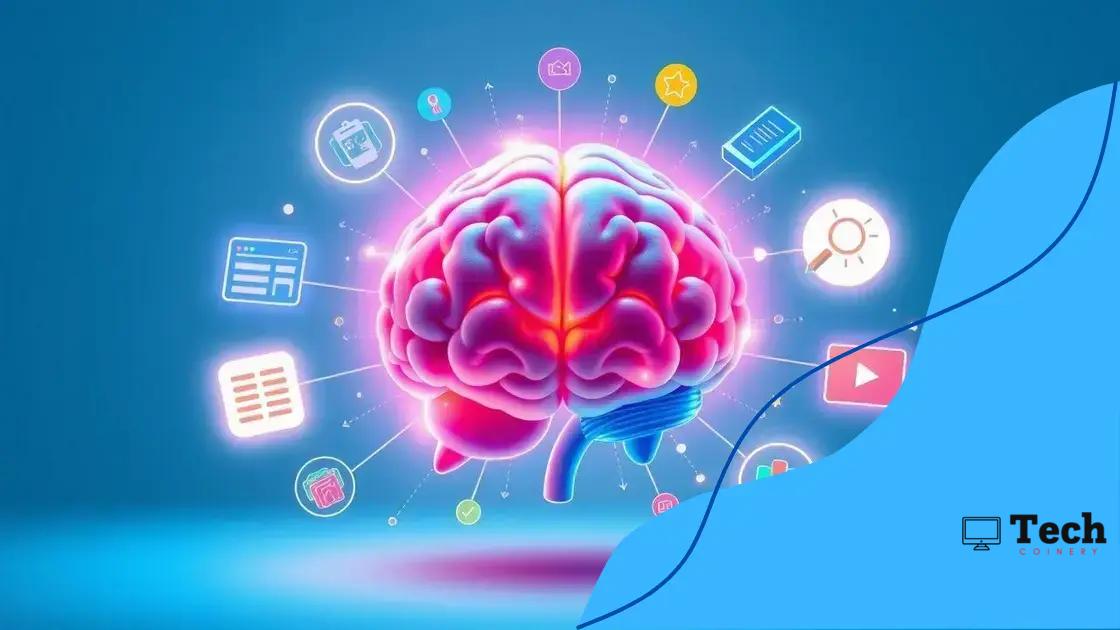The rise of microlearning: a game changer in education

The rise of microlearning is revolutionizing education by offering flexible, engaging, and personalized learning experiences through bite-sized lessons that improve retention and cater to diverse learning styles.
The rise of microlearning is reshaping how we think about education. Imagine fitting an entire lesson into just a few engaging minutes. Isn’t that intriguing? Let’s dive deeper into this fascinating trend.
Understanding microlearning and its principles
Microlearning is changing how we learn. It focuses on delivering content in small, easily digestible chunks. This approach helps learners grasp information quickly. With microlearning, lessons are often short, engaging, and targeted, making them perfect for busy schedules.
Key Principles of Microlearning
There are several key principles that define effective microlearning. Understanding these can help educators and trainers implement this method successfully.
- Focus on specific skills: Each lesson should target a specific skill or concept, allowing learners to build knowledge step by step.
- Use multimedia: Incorporating videos, quizzes, and interactive elements makes learning more engaging.
- On-the-go access: Lessons should be accessible anywhere, anytime through mobile devices.
- Frequent assessments: Regular quizzes can help reinforce learning and ensure understanding.
Another principle is the need for immediacy. Microlearning should provide instant solutions to learners’ problems. For example, if a student needs to understand a software feature quickly, a short tutorial can address that need without overwhelming them with information.
Furthermore, effective microlearning encourages social interaction. Connecting with peers through discussions or group tasks enhances learning. Sharing experiences in this manner can solidify the knowledge gained.
Benefits of Understanding Microlearning
Understanding microlearning brings multiple benefits. It increases learner engagement because shorter lessons cater to their attention spans. Moreover, learners can easily revisit materials, enhancing their retention.
- Improved retention rates: Short bursts of learning are easier to remember.
- Increased flexibility: Learners can adapt their schedules to fit learning into their daily lives.
- Cost-effective: By focusing on essential content, organizations save resources.
By embracing the principles of microlearning, educators can improve the learning experience significantly. This method not only benefits students but also helps instructors engage with their audiences more effectively.
The benefits of bite-sized lessons for learners
Bite-sized lessons are changing how learners engage with educational content. These concise lessons provide quick access to information, making learning both effective and efficient. With bite-sized lessons, students can grasp complex topics in short timeframes, fitting learning into their busy lives.
Key Benefits of Bite-sized Lessons
There are several key benefits that bite-sized lessons offer to learners. Understanding these advantages can help highlight the effectiveness of this learning approach.
- Enhanced retention: Short lessons improve memory retention. Students can better remember what they’ve learned because the information is not overwhelming.
- Flexibility: Learners can access lessons anytime and anywhere, providing control over their learning pace.
- Immediate feedback: Many bite-sized lessons include quick quizzes that allow students to assess their understanding right away.
- Engagement: Using multimedia and interactivity makes bite-sized lessons more engaging, keeping students interested and motivated.
As learners progress through these lessons, they often experience increased confidence. When complex ideas are broken down into manageable parts, students feel more capable of mastering subjects. Completing short lessons can create a sense of accomplishment.
Additionally, bite-sized lessons promote a culture of continuous learning. Since they are quick and easy to consume, learners can explore new topics regularly. This openness encourages curiosity and fosters a desire to learn more.
Examples of Bite-sized Learning
There are many formats suitable for bite-sized lessons. Video tutorials, infographics, and interactive quizzes are just a few examples. These formats are effective because they cater to different learning styles, allowing every learner to find what works best for them.
- Video clips: Short videos can demonstrate skills or concepts in a visually engaging way.
- Infographics: Visual diagrams explain complex information quickly and simply.
- Flashcards: Quick quizzes help reinforce memory and test understanding.
Bite-sized lessons create a dynamic learning experience. By focusing on short, engaging content, learners are more prepared to tackle challenges and deepen their knowledge.
How microlearning enhances retention and recall

Microlearning has a strong impact on how well we remember information. By breaking down lessons into small pieces, learners can focus better and retain more. This method makes it easier to recall details when needed, especially in high-pressure situations.
Mechanisms Behind Enhanced Retention
There are several reasons why microlearning enhances retention. Understanding these mechanisms helps highlight the effectiveness of short learning sessions.
- Reduced cognitive load: When information is presented in smaller chunks, it is less overwhelming. This allows learners to absorb material effectively without feeling stressed.
- Repetition and reinforcement: Microlearning often includes spaced repetition, a technique that helps solidify knowledge over time.
- Active engagement: Interactive elements like quizzes and videos keep learners engaged, which boosts memory retention.
- Contextual learning: Learning in context helps students connect new information to what they already know, making recall easier.
Another factor that improves retention is the use of multisensory learning. Incorporating audio, visuals, and hands-on activities in microlearning lessons makes the information stick better. When learners engage multiple senses, the brain creates stronger connections to the material.
Consistency also plays a crucial role. Regularly scheduled microlearning sessions can lead to higher retention rates. By reviewing material consistently, learners reinforce their understanding and maintain knowledge longer. This approach makes it easier to recall information, as it becomes deeply rooted in their memory.
Examples of Microlearning Techniques for Better Recall
Some effective microlearning techniques specifically target memory enhancement. These methods can greatly support learners in retaining information.
- Flashcards: These tools allow learners to test their knowledge and recall facts quickly.
- Short quizzes: Regular quizzes keep the material fresh in learners’ minds and help identify areas that need more work.
- Quick videos: Short animations or video clips explain concepts concisely, making them easier to remember.
By utilizing these techniques, microlearning helps create lasting memories. The emphasis on practical application ensures that learners can recall and use what they’ve learned effectively.
Implementing microlearning in various educational settings
Implementing microlearning can change how education is delivered across different settings. Whether in schools, corporate training, or online platforms, the adaptability of microlearning makes it effective. It allows learners to engage with content on their terms, making education more accessible and beneficial.
Microlearning in Schools
In traditional classroom settings, teachers can use microlearning to supplement lessons. Short video clips or interactive activities can reinforce concepts. Students enjoy engaging with smaller pieces of information, which helps them retain knowledge.
- Differentiated learning: Microlearning allows teachers to cater to diverse learning styles, ensuring all students benefit.
- Easy integration: Teachers can easily integrate short lessons into their existing curriculum.
- Flexible assessment: Quick quizzes or interactive polls can assess understanding without heavy testing.
Schools can also benefit from using platforms that support microlearning. For instance, educational apps and online resources provide quick access to material anytime and anywhere. This allows students to learn at their own pace.
Corporate Training with Microlearning
In the corporate world, microlearning has become essential for employee training programs. Organizations use short, focused training modules to ensure employees grasp important skills swiftly. This is particularly effective in fast-paced environments.
- Onboarding: New employees can quickly learn company policies and procedures through brief training sessions.
- Just-in-time training: Workers can access needed information right when they need it, improving productivity.
- Cost-effective: Short training sessions save time and resources, making them attractive to businesses.
Companies that adopt microlearning find it increases employee engagement. When training is bite-sized and interactive, workers are more likely to participate actively. This level of engagement can lead to better outcomes and job satisfaction.
Microlearning in Online Education
Online educational platforms are perfect for implementing microlearning. They can deliver content in various engaging formats, such as videos, infographics, or gamified lessons. This diversity accommodates different learning preferences and keeps students interested.
- Self-paced learning: Learners can progress through content at their own speed, promoting a deeper understanding.
- Instant feedback: Interactive assessments give immediate insights, enabling students to learn from mistakes.
- Community building: Forums and discussion groups can enhance the learning experience by allowing students to connect over shared interests.
The implementation of microlearning across various educational settings transforms the learning experience. By tailoring content to meet learners’ needs, education becomes more engaging and effective.
The future of education with microlearning trends
The future of education is being reshaped by emerging trends in microlearning. As technology advances, learning continues to adapt, becoming more personalized and efficient. Microlearning is at the forefront, offering innovative solutions to the challenges of traditional education.
Emerging Technologies in Microlearning
With the rise of technology, new tools enhance the microlearning experience. Virtual reality (VR) and augmented reality (AR) are changing how students interact with content. These technologies allow for immersive learning experiences that can make complex concepts easier to understand.
- Virtual reality: Students can explore 3D models and environments, which deepens their understanding of subjects like science and history.
- Augmented reality: This technology overlays digital information onto the real world, making learning more engaging and interactive.
- Mobile applications: Learning apps provide quick access to resources, allowing students to learn on the go.
Another trend is the integration of artificial intelligence (AI) in education. AI can help customize learning experiences based on individual needs. For example, AI-driven platforms can assess a learner’s progress and adapt content accordingly, ensuring that no one is left behind.
The Role of Personalization
Personalization is key in the future of education. Microlearning enables tailored learning paths for each student. This approach acknowledges that everyone learns differently and at their own pace.
- Adaptive learning: Systems adjust content difficulty based on a learner’s performance, keeping them motivated at the right level.
- Targeted feedback: Personalized assessments provide specific insights, helping learners focus on their weak points.
- Flexible content delivery: Learners can choose when and how they engage with materials.
As we look to the future, collaboration will also play a crucial role in microlearning. Online platforms promote group work and discussions, making learning a communal experience. Social learning enhances understanding by allowing students to share ideas and solve problems together.
Microlearning and Lifelong Learning
The concept of lifelong learning is becoming essential in our fast-changing world. Microlearning supports this idea by making education accessible beyond traditional schooling. Professionals can continuously upskill through bite-sized lessons, keeping their knowledge current.
- On-the-job training: Employees can engage with short courses that fit into their work hours.
- Certification programs: Many industries now offer microlearning courses for continuing education credits.
- Networking opportunities: Online courses often have forums where learners can connect with industry experts.
In conclusion, the future of education is bright with microlearning trends. As technology continues to evolve, it paves the way for a more engaging, personalized, and collaborative learning experience.
In conclusion, microlearning is reshaping the future of education. It provides a flexible, engaging, and personalized approach to learning. With advances in technology, such as virtual reality and artificial intelligence, education becomes more accessible. This method not only enhances retention but also promotes lifelong learning and collaboration among students. As microlearning continues to evolve, it prepares learners for a rapidly changing world and equips them with the skills they need for success.
FAQ – Frequently Asked Questions about Microlearning and Its Future
What is microlearning?
Microlearning is an educational approach that delivers content in small, easily digestible segments. It focuses on short lessons that enhance understanding and retention.
How does microlearning improve engagement?
Microlearning uses interactive elements, such as quizzes and multimedia, to keep learners interested. This approach makes learning more dynamic and less overwhelming.
What are some examples of microlearning in education?
Examples include short video tutorials, interactive apps, quizzes, and infographics that provide quick access to important information.
How does microlearning support lifelong learning?
Microlearning offers flexible learning opportunities that enable individuals to continuously update their skills, making education accessible beyond traditional settings.






